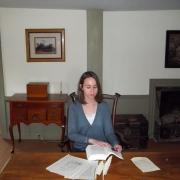Biographies
A tulip in winter : a story about folk artist Maud Lewis
Kathy Stinson
j759.11 Lewis
Art / Art History, Kids, Biographies
"A celebration of a beloved folk artist, and her artistic expression of joy and beauty. Known for her vibrant and cheerful paintings of landscapes, plants, and animals, Maud Lewis' iconic folk art is celebrated around the world. Despite her beautiful art, she spent much of her life living in poverty with rheumatoid arthritis. In this stunning picture book, author Kathy Stinson and illustrator Lauren Soloy bring Maud's world to life: how she captured in her art what she loved most, while navigating the mobility issues caused by her condition. From bright paintings of the sea and countryside, to the flowers and birds she painted on the walls of the small house she shared with her husband, Maud's work continues to delight and inspire viewers young and old."--
The untold story of Larry Itliong : labor rights hero
Cristina Oxtra
j331.88 Itliong
Biographies, History
"You may have read about Cesar Chavez's leadership in organizing the well-known Delano Grape Strike and Boycott of the 1960s. But did you know it began as a strike led by Larry Itliong? He was a Filipino labor organizer who had also been working with grape pickers in California at the time. With key biographical information and related historical events, this Capstone Captivate book will uncover Itliong's story and show how it connects to Chavez's story"--
Take this opportunity to learn about an unsung hero of history and glean more information about where your food comes from! -Anne W
The revolutionary : Samuel Adams
Stacy Schiff
BIOGRAPHY Adams, Samuel
History, Biographies
"Thomas Jefferson asserted that if there was any leader of the Revolution, "Samuel Adams was the man." With high-minded ideals and bare-knuckle tactics, Adams led what could be called the greatest campaign of civil resistance in American history. Stacy Schiff returns Adams to his seat of glory, introducing us to the shrewd and eloquent man who supplied the moral backbone of the American Revolution. He employed every tool available to rally a town, a colony, and eventually a band of colonies behind him, creating the cause that created a country. For his efforts he became the most wanted man in America: When Paul Revere rode to Lexington in 1775, it was to warn Samuel Adams that he was about to be arrested for treason. In The Revolutionary: Samuel Adams, Schiff brings her masterful skills to Adams's improbable life, illuminating his transformation from aimless son of a well-off family to tireless, beguiling radical who mobilized the colonies"--
I really enjoy Schiff’s biographies and histories. She wrote one on Cleopatra and another called "The Witches," which chronicles the New England witchcraft hysteria of the 17th century. Both I recommend highly. Schiff is a great storyteller. She knows how to set the scene, provides interesting context, and then introduces her subject. This time it is founding father and known trouble-maker Samuel Adams. Now sort of a footnote in Revolutionary history, Adams played a huge role in providing unrelenting criticism of the king and parliament, leading to our country’s independence from Britain. Why was his legacy buried? Schiff's take is pretty interesting, especially through our 21st century lens. -Anne M
Number one is walking : my life in the movies and other diversions
Steve Martin
791.43028092 /Martin
Biographies, Humor
"Number One Is Walking is Steve Martin's cinematic legacy-an illustrated memoir of his legendary acting career, with stories from his most popular films and artwork by New Yorker cartoonist Harry Bliss. Steve Martin has never written about his career in the movies before. In Number One Is Walking, he shares anecdotes from the sets of his beloved films-Father of the Bride, Roxanne, The Jerk, Three Amigos, and many more-bringing readers directly into his world. He shares charming tales of antics, moments of inspiration, and exploits with the likes of Paul McCartney, Diane Keaton, Harrison Ford, and Chevy Chase. Martin details his forty years in the movie biz, as well as his stand-up comedy, banjo playing, writing, and cartooning, all with his unparalleled wit. With gorgeously illustrated cartoons and single-panel "diversions" in Steve and Harry's signature style, Number One Is Walking is full of the everyday moments that make up a movie star's life, capturing Steve Martin's singular humor and acclaimed career in film. The perfect gift from the team who brought you the #1 New York Times bestseller A Wealth of Pigeons"--
I am a sucker for graphic novel style memoirs. As a Gen-Y'er, I grew up with the Steve Martin movies from the '80s--Little Shop of Horrors, Roxanne, L.A. Story. L.A. Story remains one of my all-time favorites, and Roxanne got me started on my Cyrano de Bergerac kick in high school. (I made it a point to read every translation and watch every adaptation that I could get my hands on.) This illustrated memoir of his time in Hollywood offers his delightful and comedic behind-the-scenes take on working in the biz. This book is sure to be one of the best celebrity memoirs of 2022. -Melody
The swerve : how the world became modern
Stephen Greenblatt
940.21 /Greenblatt
Nonfiction, History, Philosophy, Biographies
In this work, the author has crafted both a work of history and a story of discovery, in which one manuscript, plucked from a thousand years of neglect, changed the course of human thought and made possible the world as we know it. Nearly six hundred years ago, a short, genial, cannily alert man in his late thirties took a very old manuscript off a library shelf, saw with excitement what he had discovered, and ordered that it be copied. That book was the last surviving manuscript of an ancient Roman philosophical epic, On the Nature of Things, by Lucretius, a beautiful poem of the most dangerous ideas: that the universe functioned without the aid of gods, that religious fear was damaging to human life, and that matter was made up of very small particles in eternal motion, colliding and swerving in new directions. The copying and translation of this ancient book, the greatest discovery of the greatest book-hunter of his age, fueled the Renaissance, inspiring artists such as Botticelli and thinkers such as Giordano Bruno; shaped the thought of Galileo and Freud, Darwin and Einstein; and had a revolutionary influence on writers such as Montaigne and Shakespeare and even Thomas Jefferson.
I'm a little late to this book, but I am so glad that I am reading it (on the recommendation of Natalie Haynes, for you podcast lovers!). This book so eloquently relays an important aspect of the humanism movement--that of finding and preserving and making known again--works from the Romans and Greeks. In this case, our questing hero goes by the name of Poggio, and he re-discovers a text by the Roman thinker Lucretius, who had been heavily influenced by Greek philosopher Epicurus. It's a layer cake of scrumptious meditation on how to live, combined with juicy details of the lives of Romans and Florentines--a real treat! -Candice
The Facemaker: A Visionary Surgeon's Battle to Mend the Disfigured Soldiers of World War I
Lindsey Fitzharris
OverDrive Audiobook
Literary Nonfiction, History, Biographies
From the moment the first machine gun rang out over the Western Front, one thing was clear: mankind's military technology had wildly surpassed its medical capabilities. Bodies were battered, gouged, hacked, and gassed. The First World War claimed millions of lives and left millions more wounded and disfigured. In the midst of this brutality, however, there were also those who strove to alleviate suffering. The Facemaker tells the extraordinary story of such an individual: the pioneering plastic surgeon Harold Gillies, who dedicated himself to reconstructing the burned and broken faces of the injured soldiers under his care. Gillies, a Cambridge-educated New Zealander, became interested in the nascent field of plastic surgery after encountering the human wreckage on the front. Returning to Britain, he established one of the world's first hospitals dedicated entirely to facial reconstruction. There, Gillies assembled a unique group of practitioners whose task was to rebuild what had been torn apart, to re-create what had been destroyed. At a time when losing a limb made a soldier a hero, but losing a face made him a monster to a society largely intolerant of disfigurement, Gillies restored not just the faces of the wounded but also their spirits. .
This book is devastating and hopeful at the same time. It is a story that starts out harrowing, but after hard work and ingenuity by a few individuals, things change for the better. The Facemaker, a history of World War I facial reconstruction, sets the scene: how World War I was fought in new and horrific ways. It was industrial. There were a lot of advancements in weapons of war. (And of course, for what?) Lindsey Fitzharris describes this moment in time very well. Then there are the people put in the trenches and at sea and in the air, not to mention the civilians, facing this new weaponry. Fitzharris makes these stories personal and individual, the pain experienced both inside and out. She picks a number of individuals that came home with significant facial injuries and how they viewed their lives as over. Enter Harold Gillies, an ears, nose, and throat doctor, who is about to become the leading expert in facial reconstruction. If you love compelling histories of war or medicine, I recommend this book. As an aside, the audio version was excellently narrated. -Anne M
As it turns out : thinking about Edie and Andy
Alice Sedgwick Wohl
BIOGRAPHY Sedgwick, Edie
Biographies
"The story of model, actress, and American icon Edie Sedgwick, told by her sister with unfailing empathy, sharp insight, and firsthand observations of her whirlwind life"--
A good bit of this book focuses on the dysfunctional family dynasty that produced Edie Sedgwick, and then hyper-focuses on Edie's time with Andy Warhol. Pretty fascinating for those interested in the New York art world of the 20th century. -Amanda
American demon : Eliot Ness and the hunt for America's Jack the Ripper
Stashower, Daniel, author.
364.1523/Stashower (NEW)
True Crime, Biographies, History
Stashower (Teller of Tales) traces Eliot Ness's career with a focus on the media-named Torso Murders, which shook the city of Cleveland. Over a course of three years, citizens discovered bundles of dismembered body parts. Twelve killings in all were ascribed to the unknown assailant, dubbed the Mad Butcher, and only two victims were positively identified. Ness was famous for his work in Al Capone's downfall. After some less prestigious work shutting down moonshine stills in the mountains, Ness landed a job that played to his strengths: Cleveland's safety director. Here he could modernize the police force, use his gang busting skills against the city's organized crime, and ferret out corruption within the ranks. Cleveland needed this, but what the city wanted was a hero who could stop the Mad Butcher. Stashower's Ness is a flawed do-gooder, frustrated by city politics, sullied by personal indiscretions, and taunted by postcards from the man he suspected was the Mad Butcher but couldn't prove. VERDICT Stashower was born in Cleveland, and his personal connection to the city breathes life into this well-researched and chilling account.—Terry Bosky Copyright 2022 Library Journal.
Just what did Eliot Ness get up to after taking down Al Capone? -Candice
The Godmother : murder, vengeance, and the bloody struggle of Mafia women
Nadeau, Barbie Latza, author.
364.106/Nadeau
True Crime, Biographies
In this engrossing account, Nadeau (Roadmap to Hell: Sex, Drugs and Guns on the Mafia Coast) combines diligent research, hours of personal interviews, and vivid prose to immerse the reader in the world of Italian Mafia women. Nadeau tells the stories of those who defected and turned evidence against the mob, such as wives who betrayed their husbands, but she focuses on the unrepentant women, Assanta "Pupetta" Maresca chief among them. Born into a crime family in 1935, she married a mobster who was assassinated when she was 18 and pregnant. To retaliate, Maresca pumped 29 bullets into the man who ordered the hit and spent the next 10 years in prison, where she gave birth to her son, before being pardoned for the murder in 1965. She went on to remarry a mob underboss, but was sent back to prison in 1978 for another murder, which was overturned on appeal four years later. Maresca spent the 1980s wielding enormous influence in the crime organization, revered as the godmother and the Lady of Camorra. Even in her old age, she was celebrated as a self-made woman and was the first Mafia woman to be banned from having a public funeral due to her bloodthirsty life, when she died on New Year's Eve 2021. This look at the "feminine" side of the Mafia is a must for true crime fans. (Sept.) Copyright 2022 Publishers Weekly.
This doesn't really need an explanation, it's just one of those slice-of-life books where that slice is so storied, all mystery and danger, and so different from our own. -Candice
Last call at the Hotel Imperial : the reporters who took on a world at war
Deborah Cohen
070.922 /Cohen
Nonfiction, Biographies, History
"Married foreign correspondents John and Frances Gunther intimately understood that it isn't only impersonal, economic forces that propel history, bringing readers so close to the front lines of history that they could feel how personal pathologies became the stuff of geopolitical crises. Together with other reporters of the Lost Generation--American journalists H.R. Knickerbocker, Vincent Sheean, and Dorothy Thompson--the Gunthers slipped through knots of surveillance and ignored orders of expulsion in order to expose the mass executions in Badajoz during the Spanish Civil War, the Nazi-Soviet Non-Aggression Pact, the millions of dollars that Joseph Goebbels salted away abroad, and the sexual peccadillos of Hitler's brownshirts. They conjured what it was like to ride with Hitler in an airplane ("not a word did he say to any soul"); broke the inside story about Mussolini's claustrophobia and superstitions (he "took fright" at an Egyptian mummy that had been given to him); and verified the hypnotic impression Stalin made when he walked into a room ("You felt his antennae"). But just as they were transforming journalism, it was also transforming them: who they loved and betrayed, how they raised their children and coped with death. Over the course of their careers they would popularize bringing the private life into public view, not only in their reporting on the outsized figures of their day, but in what they revealed about their own (and each other's) intimate experiences as well. What were intimate relationships, after all, but geopolitics writ small?"--
I thought this book had a slow start, but as soon as we got to Europe and in the thick of war reporting, I was hooked. Learning about Dorothy Thompson, Frances Gunther, John Gunther, H.R. Knickerbocker, and Vincent Sheean and how they reported on Europe in the 1930s and 1940s showed how important journalists are. -Anne M






Maud Lewis' lively, colorful paintings were inspired by the countryside around her tiny house in Nova Scotia. Disabled by severe rheumatoid arthritis, and with options further limited by poverty, Lewis lived in a tiny house she decorated by painting flowers all over the stairs, walls, and many of her belongings, along with creating landscapes on scraps of wood and cardboard from the dump. Today, her house can be seen, in its entirety, inside the Art Gallery of Nova Scotia, where it was moved after her death in 1970. -Anne W